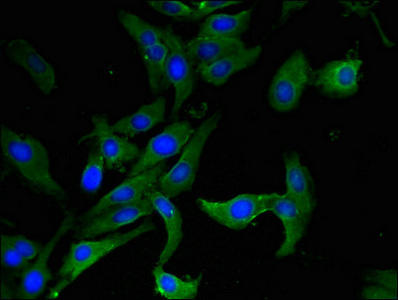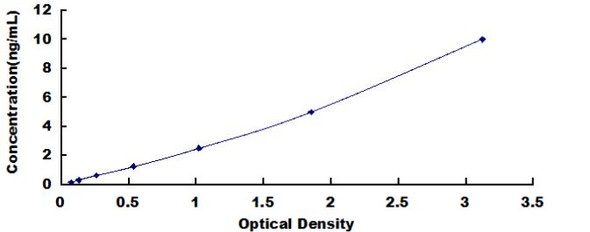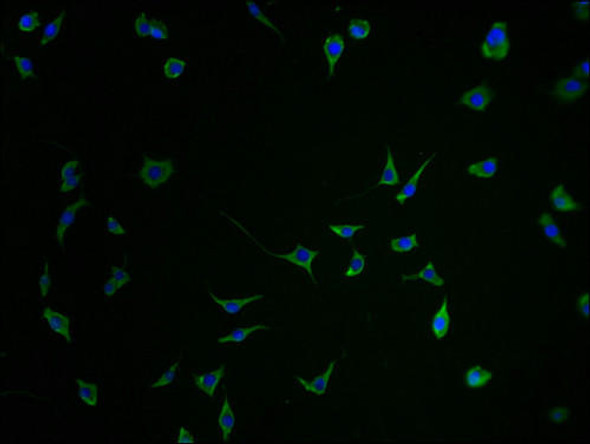AHRR Antibody (PACO49386)
- SKU:
- PACO49386
- Product Type:
- Antibody
- Reactivity:
- Human
- Host Species:
- Rabbit
- Isotype:
- IgG
- Applications:
- ELISA
- IF
- Antibody Type:
- Polyclonal Antibody
- Conjugation:
- Unconjugated
Description
AHRR Antibody (PACO49386)
The AHRR Polyclonal Antibody (PAC049386) is essential for researchers studying the Aryl hydrocarbon receptor repressor (AHRR), a transcriptional regulator involved in the detoxification of environmental toxins and the metabolism of endogenous compounds. This antibody, generated in rabbits, exhibits high specificity for human samples and is validated for use in Western blot applications, allowing for precise detection of the AHRR protein in various cell types.AHRR plays a crucial role in controlling the expression of genes involved in various physiological processes, making it a key target for investigations in toxicology, environmental health, and metabolic disorders.
By uncovering the mechanisms by which AHRR regulates gene expression, researchers can gain insights into the impact of environmental pollutants on human health and development potential therapeutic interventions for related conditions.With its high reactivity and specificity, the AHRR Polyclonal Antibody is a valuable tool for researchers seeking to unravel the complex functions of AHRR and its implications in human health and disease.
| Antibody Name: | AHRR Antibody (PACO49386) |
| Antibody SKU: | PACO49386 |
| Size: | 50ug |
| Host Species: | Rabbit |
| Tested Applications: | ELISA, IF |
| Recommended Dilutions: | ELISA:1:2000-1:10000, IF:1:50-1:200 |
| Species Reactivity: | Human |
| Immunogen: | Recombinant Human Aryl hydrocarbon receptor repressor protein (255-506AA) |
| Form: | Liquid |
| Storage Buffer: | Preservative: 0.03% Proclin 300 Constituents: 50% Glycerol, 0.01M PBS, pH 7.4 |
| Purification Method: | >95%, Protein G purified |
| Clonality: | Polyclonal |
| Isotype: | IgG |
| Conjugate: | Non-conjugated |
 | Immunofluorescent analysis of Hela cells using PACO49386 at dilution of 1:100 and Alexa Fluor 488-congugated AffiniPure Goat Anti-Rabbit IgG(H+L). |
| Background: | Mediates dioxin toxicity and is involved in regulation of cell growth and differentiation. Represses the transcription activity of AHR by competing with this transcription factor for heterodimer formation with the ARNT and subsequently binding to the xenobiotic response element (XRE) sequence present in the promoter regulatory region of variety of genes. Represses CYP1A1 by binding the XRE sequence and recruiting ANKRA2, HDAC4 and/or HDAC5. Autoregulates its expression by associating with its own XRE site. |
| Synonyms: | Aryl hydrocarbon receptor repressor (AhR repressor) (AhRR) (Class E basic helix-loop-helix protein 77) (bHLHe77), AHRR, BHLHE77 KIAA1234 |
| UniProt Protein Function: | AHR: a nuclear receptor for aryl hydrocarbons involved in xenobiotic metabolism, cell cycle regulation, and development in response to both endogenous and environmental signals. AhR was initially identified as a receptor for dioxins, which are environmental pollutants generated by waste incineration and other industrial processes. AhR ligands include polycyclic aromatic hydrocarbons, including the carcinogen benzo(a)pyrene and other components of cigarette smoke. Naturally occurring AhR ligands include flavonoids, which are aromatic plant secondary compounds commonly found in vegetables and fruits. Cytoplasmic aryl hydrocarbon receptors are found in protein complexes with heat shock proteins. Upon ligand binding, AhR dissociates from heat shock proteins and translocate to the nucleus where it dimerizes with AhR nuclear translocator (ARNT, HIF-1b). The AhR/ARNT heterodimer binds to nuclear xenobiotic response elements to control the expression of genes associated with xenobiotic metabolism, including several cytochrome P450 genes. AhR is ubiquitously expressed and is thought to play a role in regulation of cell proliferation and differentiation, cytokine expression, and xenobiotic metabolism. Research studies link AhR activity with the control of regulatory T-cell and T-helper 17 cell differentiation, regulation of the inflammatory response, and the onset of lung cancer. |
| UniProt Protein Details: | Protein type:DNA-binding; Transcription factor; Nuclear receptor Chromosomal Location of Human Ortholog: 7p15 Cellular Component: nucleoplasm; transcription factor complex; cytoplasm; nucleus Molecular Function:RNA polymerase II transcription factor activity, enhancer binding; protein dimerization activity; signal transducer activity; protein binding; ligand-dependent nuclear receptor activity; DNA binding; sequence-specific DNA binding; protein heterodimerization activity; Hsp90 protein binding; transcription factor activity; transcription factor binding Biological Process: transcription from RNA polymerase II promoter; prostate gland development; blood vessel development; intracellular receptor-mediated signaling pathway; apoptosis; response to toxin; positive regulation of transcription, DNA-dependent; negative regulation of transcription from RNA polymerase II promoter; cell cycle; regulation of transcription from RNA polymerase II promoter; response to xenobiotic stimulus; regulation of transcription, DNA-dependent; regulation of gene expression; xenobiotic metabolic process; positive regulation of transcription from RNA polymerase II promoter; regulation of B cell proliferation; circadian regulation of gene expression; positive regulation of transcriptional preinitiation complex assembly; negative regulation of transcription, DNA-dependent |
| NCBI Summary: | The protein encoded by this gene is a ligand-activated helix-loop-helix transcription factor involved in the regulation of biological responses to planar aromatic hydrocarbons. This receptor has been shown to regulate xenobiotic-metabolizing enzymes such as cytochrome P450. Before ligand binding, the encoded protein is sequestered in the cytoplasm; upon ligand binding, this protein moves to the nucleus and stimulates transcription of target genes. [provided by RefSeq, Sep 2015] |
| UniProt Code: | A9YTQ3 |
| NCBI GenInfo Identifier: | 4502003 |
| NCBI Gene ID: | 196 |
| NCBI Accession: | NP_001612.1 |
| UniProt Secondary Accession: | A9YTQ3,A9YTQ3, |
| UniProt Related Accession: | P35869 |
| Molecular Weight: | |
| NCBI Full Name: | aryl hydrocarbon receptor |
| NCBI Synonym Full Names: | aryl hydrocarbon receptor |
| NCBI Official Symbol: | AHR |
| NCBI Official Synonym Symbols: | RP85; bHLHe76 |
| NCBI Protein Information: | aryl hydrocarbon receptor |
| UniProt Protein Name: | Aryl hydrocarbon receptor |
| UniProt Synonym Protein Names: | Class E basic helix-loop-helix protein 76 |
| Protein Family: | Aldehyde reductase |
| UniProt Gene Name: | AHR |
| UniProt Entry Name: | AHR_HUMAN |











